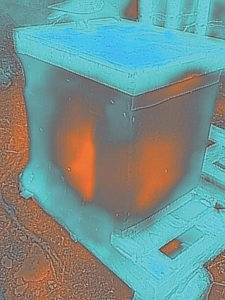Hive entrances are eerily vacant and quiet this frigid November morning, but an ear to the boxes reveals lots of life inside. A healthy cluster of wintering honey bees emits a low and steady hum — the sound of thousands of bee-muscle contractions, fueled by stored honey and generating heat to share.
Unlike our native social bees, which overwinter as solitary hibernating mated queens, European honey bees pass the winter in large colonies that are metabolically active. With the queen always in the center, the honey bee winter cluster shrinks and swells with falling and rising outside temperatures. In this way a healthy colony thermoregulates, maintaining a nearly constant central temperature in the 50s F, despite wild swings in air temperature and wind chill just inches away.

The coordination involved is intricate: bees in the center of the cluster do most of the heat generation, while others form an insulating shell around them. When these bold outside workers start to chill to a critical temperature, they save themselves by diving deep into the warm cluster’s interior, to be replaced by warm nestmates.
The strategy is to conserve fuel: 40 to 60 pounds of honey that a strong colony has stored for a flowerless Cape Cod winter. Honey bee scientists view those thousands of individual bees in the wintering cluster as a single organism, or “superorganism,” when it comes to the way thermoregulation works. Their studies have shown that the colony’s minimal metabolic rate, and maximum honey conservation, occurs at about 40 degrees. Below this temperature, honey consumption and heating must increase to prevent the entire cluster from freezing. Temperatures above the low 40s cause the bees to become more active and burn more energy.
Ever since the invasion of the parasitic mite (Varroa destructor) on Cape Cod in the late 1980s, maintaining honey bee colonies here through the fall and winter has gotten a lot more complicated. Gone are the halcyon pre-mite days when even incompetent beekeepers, so long as they left enough honey on the hives in the fall for the bees, could count on live colonies in the spring.
The problem is that until recently the western honey bee, Apis mellifera from Europe, and the varroa mite from Asia had never met, so the two haven’t had a long period of co-evolution to develop a happy or, rather, adaptive, host-parasite relationship. Mite infestations of honey bee colonies in North America are currently virulent and often lethal. Besides feeding on wintering bees’ fat and protein reserves, otherwise essential for the rearing of healthy bee offspring in late winter and spring, varroa mites transmit debilitating bee viruses.
Nature will eventually find a way for bees and mites to live together: some honey bees are already becoming more mite-resistant, and mites may become less virulent; it’s not smart for a parasite to kill its host. But in the meantime the successful beekeeper has to intercede.
When varroa mites first arrived on the Cape, many beekeepers turned to strong pesticides, but these stressed the bees, accumulated in beeswax and became ineffective as the mites fairly quickly developed resistance. Now there are more benign alternatives that rely on regular mite monitoring, complicated hive-management strategies, and the application of naturally occurring acids and essential oils that kill mites with less stress to the bees.
The need to manage varroa has made beekeeping a lot more work. The chance to see thousands of healthy worker bees bursting from the hives in spring makes it worth the effort.



